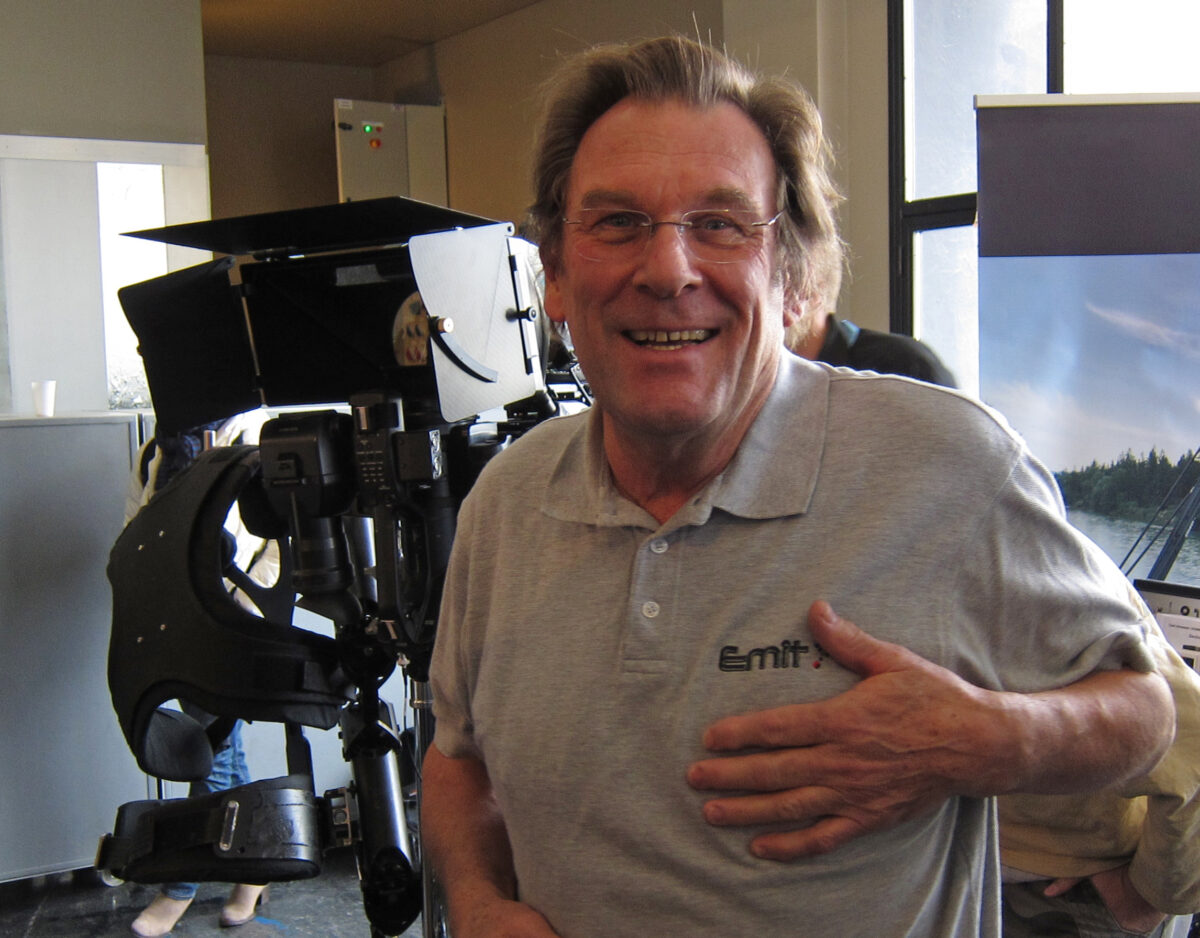Trevor Steele passed away in Paris on Dec 20, 2023 He was a beloved, influential, innovative pillar of the cinema industry. Trevor was the center of attention, an optical centering, the life of the party wherever he went. He could explain technical details, and almost anything else, with great clarity, charm and wit.
Trevor was born in Sevenoaks, Kent, on the South Coast of England. He attended a good public school. When he was eight, the family moved to Palmers Green in North London. Trevor had no friends when he arrived until he met a boy named George Hill. They became a lifelong buddies. “We did practically everything together as young boys do,” Trevor said in a 2012 FDTimes article. “We played and went bicycling together. We joined the church choir. The church was named St. Cuthbert’s, at Chitts Hill in North London. George went on to a technical college called Arnos Grove. He trained as a technician to work a lathe and all the machinery. I failed miserably in grammar school and came out with achievements in French and woodworking. Reading, writing and arithmetic went by the board. I confused geography with history. But I did very well in French, which of course, helped later on.”
One of Trevor’s first jobs was as a projector technician for Cinex in London. They were the importers of the famous Paillard Bolex H-16 cameras and other equipment. Trevor stayed with that company for more than 15 years, gradually working his way up from Technician on the bench to Section Leader, Assistant Service Manager, and ending up as Technical Manager. He travelled to Switzerland often for intensive training courses.
Trevor got involved with the Bolex 16 Pro camera, designed and developed in Munich, and way ahead of its time except for one detail: you had to cut the film to remove it from the magazine. He gained valuable experience learning how to shoot a film as part of a crew working with Swiss television.
In 1965, Kodak (with sales of more than $1 billion a year and 75,000 employees) came out with Super 8. Bolex was slow to adopt the new format. Trevor was out of work for a few months when he got a call from Éclair Debrie UK. This company was created by Harry Saltzman, Producer of the James Bond films.
Trevor explained, “Saltzman had saved the tragically ailing Éclair International Company and the Andre Debrie Film Processing and Printing Factories in France. He opened up the subsidiary in London to be able to produce this equipment cheaper. I was invited to join them. I was the first person to be employed by that company. I stayed there for three or four years and everything just turned to gold for me. I was responsible for setting up the the camera production line and the after-sales service. And then later on technical sales. I joined Éclair International Cameras (E.I.C.) in rue Gaillon near the Opera in Paris, and later just off the Champs-Elysees near the Arc de Triomphe.
“I travelled around the world to train technicians on the NPR, ACL, and other cameras, and bring back news of potential sales. We started a training school. We trained some 150 technicians over a period of four or five years. Which meant that there were plenty of technicians available to service Éclair cameras. But Éclair was about to fail. All the staff were laid off except myself, Manfred Tosseram, Michel Vacar, and Madame Gauthrie. Jean-Pierre Beauviala was called in to assist. There were no new orders for Éclair cameras because with the new Aaton and Arriflex 16mm cameras, the market was already saturated and video was coming in very fast. The writing was on the wall. There was no future for Éclair. Mr. Beauviala was very kind to me personally when it came to the showdown at the end.”
And that is how EMIT began in 1982. Trevor, Manfred Tosseram, and Michel Vacar created the company to assist the Éclair camera factory to export their spare parts back orders and accessories. The company was called “Modern Image Techniques.” It was set up at Epinay-sur-Seine, some 12 kilometers North of Paris, the hometown of Éclair Processing Labs, cutting rooms, and the famous Éclair Film Production Company with the largest sound stage in Europe at that time.
“Modern Image Techniques” became EMIT. Andrew Steele explained, “Because there was a big university in Boston named MIT, and not wishing to be pretentious, they chose a four letter word which could be pronounced easily in most languages. They added the ‘E,’ which is the first letter of Equipment, Electronics, Efficiency, Emitter, Éclair, Etc. They brought in Cooke lenses from the UK and PAG batteries, Chrosziel matteboxes and follow focus, and Panther dollies—under FGV at the time.”
Trevor will be missed by so many of us.










Travel well. RIP Trevor Steele.
The Covell family are deeply saddened by this news. We go back decades with Trevor. Thinking about it, I must have first met Trevor in the early 80s as a boy, and my father, Tony, knew Trevor even longer. He will be missed.
Like many of us, I have many memories attached to the person of Trevor. It’s been a long time since he retired from onset and trade show activities, but even so, he is a key man in our creative industry who is leaving us.
Probably the first person I met who showed me to what extent Image construction, technological evolution, intelligent business and the pleasure of working among enthusiasts were interconnected and inseparable facets of the profession
I keep intact the memory of his humor, his commitment and the little sparkling lights in his eyes when we worked together!
so long dear Trevor
Fabien Pisano, Sony Europe